window SMART FORTWO COUPE ELECTRIC DRIVE 2015 Owners Manual
[x] Cancel search | Manufacturer: SMART, Model Year: 2015, Model line: FORTWO COUPE ELECTRIC DRIVE, Model: SMART FORTWO COUPE ELECTRIC DRIVE 2015Pages: 222, PDF Size: 5.02 MB
Page 6 of 222
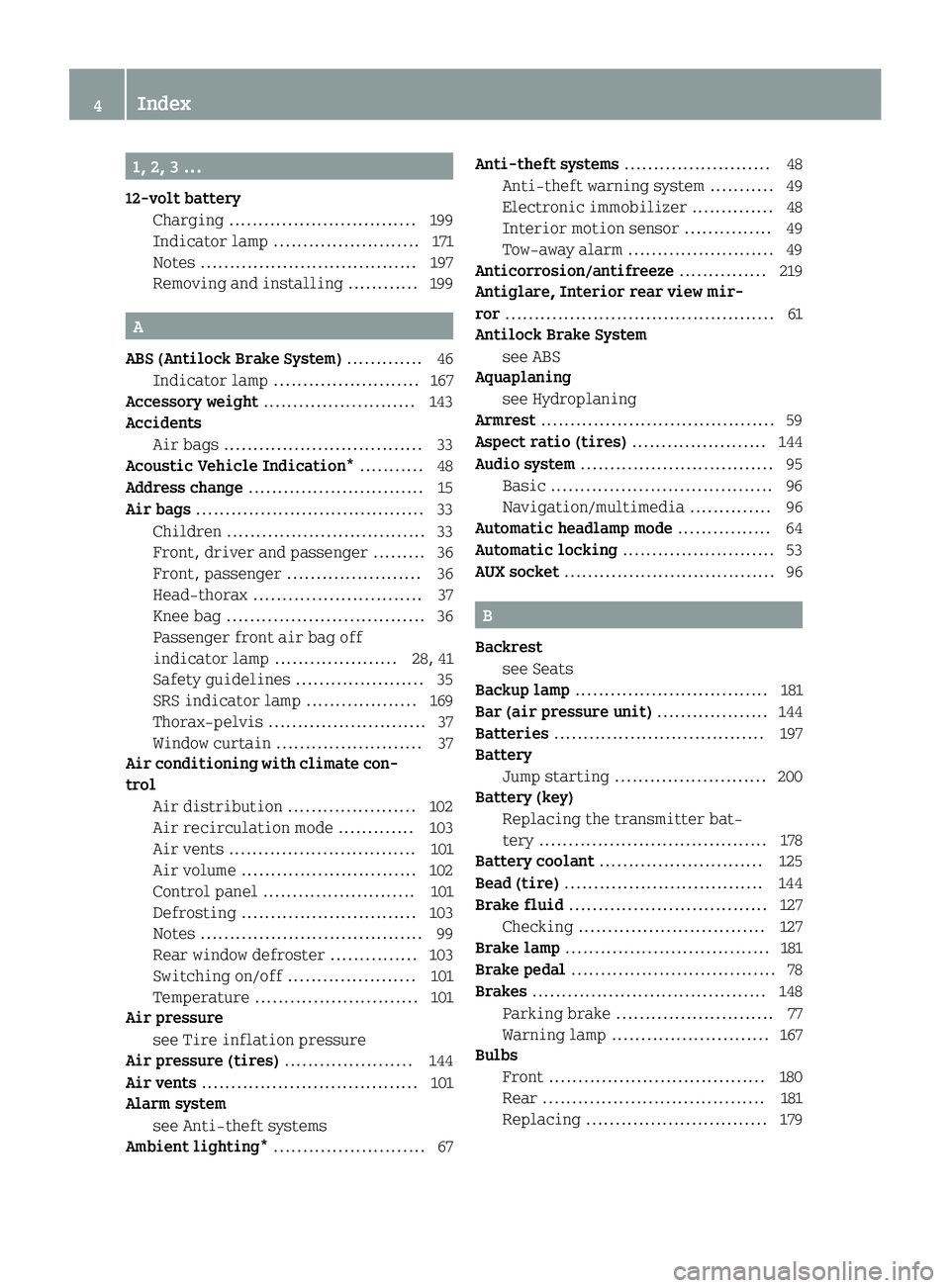
1, 2, 3 ...
12-volt battery Charging ................................ 199
Indicator lamp ........................ .171
Notes ..................................... 197
Removing and installing ............ 199 A
ABS (Antilock Brake System) ............. 46
Indicator lamp .........................1 67
Accessory weight .......................... 143
Accidents
Air bags .................................. 33
Acoustic Vehicle Indication* ........... 48
Address change .............................. 15
Air bags ....................................... 33
Children .................................. 33
Front, driver and passenger ......... 36
Front, passenger ....................... 36
Head-thorax ............................. 37
Knee bag .................................. 36
Passenger front air bag off
indicator lamp ..................... 28, 41
Safety guidelines ...................... 35
SRS indicator lamp ...................1 69
Thorax-pelvis ........................... 37
Window curtain ......................... 37
Air conditioning with climate con-
trol
Air distribution ...................... 102
Air recirculation mode .............1 03
Air vents ................................ 101
Air volume .............................. 102
Control panel .......................... 101
Defrosting .............................. 103
Notes ...................................... 99
Rear window defroster ............... 103
Switching on/off ...................... 101
Temperature ............................ 101
Air pressure
see Tire inflation pressure
Air pressure (tires) ...................... 144
Air vents .................................... .101
Alarm system
see Anti-theft systems
Ambient lighting* .......................... 67 Anti-theft systems
.........................48
Anti-theft warning system ........... 49
Electronic immobilizer .............. 48
Interior motion sensor ............... 49
Tow-away alarm .........................49
Anticorrosion/antifreeze ............... 219
Antiglare, Interior rear view mir-
ror .............................................. 61
Antilock Brake System
see ABS
Aquaplaning
see Hydroplaning
Armrest ........................................ 59
Aspect ratio (tires) ....................... 144
Audio system .................................95
Basic ...................................... 96
Navigation/multimedia .............. 96
Automatic headlamp mode ................64
Automatic locking .......................... 53
AUX socket .................................... 96 B
Backrest see Seats
Backup lamp .................................1 81
Bar (air pressure unit) ...................144
Batteries ....................................1 97
Battery
Jump starting .......................... 200
Battery (key)
Replacing the transmitter bat-
tery ....................................... 178
Battery coolant ............................ 125
Bead (tire) .................................. 144
Brake fluid .................................. 127
Checking ................................ 127
Brake lamp ................................... 181
Brake pedal ................................... 78
Brakes ........................................ 148
Parking brake ........................... 77
Warning lamp ........................... 167
Bulbs
Front .................................... .180
Rear ...................................... 181
Replacing .............................. .179 4
Index
Page 7 of 222
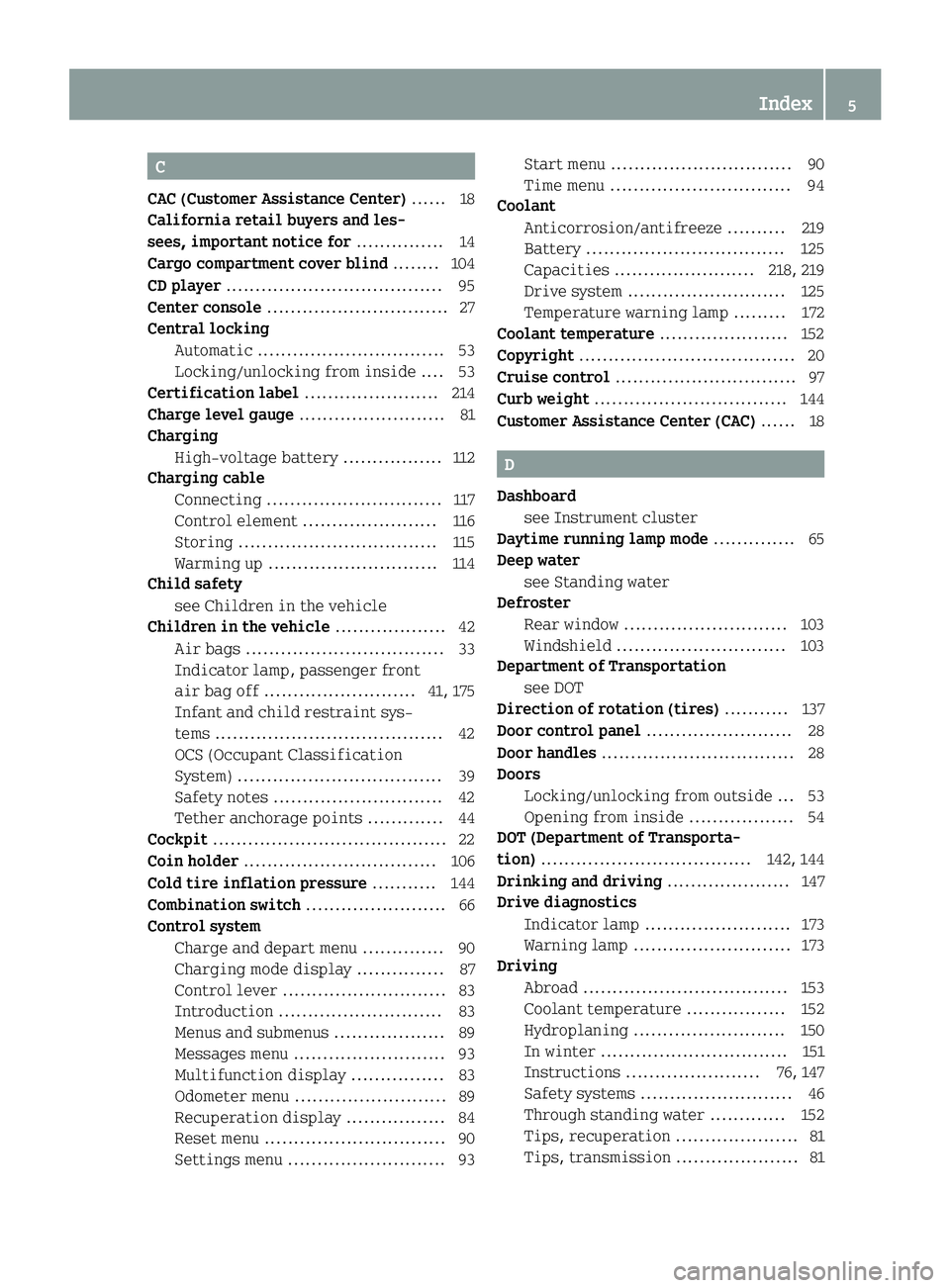
C
CAC (Customer Assistance Center) ...... 18
California retail buyers and les-
sees, important notice for ............... 14
Cargo compartment cover blind ........ 104
CD player ..................................... 95
Center console ............................... 27
Central locking
Automatic ................................ 53
Locking/unlocking from inside .... 53
Certification label ....................... 214
Charge level gauge ......................... 81
Charging
High-voltage battery ................. 112
Charging cable
Connecting .............................. 117
Control element ....................... 116
Storing .................................. 115
Warming up ............................. 114
Child safety
see Children in the vehicle
Children in the vehicle ................... 42
Air bags .................................. 33
Indicator lamp, passenger front
air bag off .......................... 41, 175
Infant and child restraint sys-
tems ....................................... 42
OCS (Occupant Classification
System) ................................... 39
Safety notes ............................. 42
Tether anchorage points ............. 44
Cockpit ........................................ 22
Coin holder ................................. 106
Cold tire inflation pressure ........... 144
Combination switch ........................ 66
Control system
Charge and depart menu .............. 90
Charging mode display ............... 87
Control lever ............................ 83
Introduction ............................ 83
Menus and submenus ................... 89
Messages menu .......................... 93
Multifunction display ................ 83
Odometer menu .......................... 89
Recuperation display ................. 84
Reset menu ............................... 90
Settings menu ........................... 93 Start menu ............................... 90
Time menu ............................... 94
Coolant
Anticorrosion/antifreeze .......... 219
Battery .................................. 125
Capacities ........................ 218, 219
Drive system ........................... 125
Temperature warning lamp ......... 172
Coolant temperature ...................... 152
Copyright ..................................... 20
Cruise control ............................... 97
Curb weight ................................. 144
Customer Assistance Center (CAC) ...... 18 D
Dashboard see Instrument cluster
Daytime running lamp mode .............. 65
Deep water
see Standing water
Defroster
Rear window ............................ 103
Windshield ............................. 103
Department of Transportation
see DOT
Direction of rotation (tires) ........... 137
Door control panel ......................... 28
Door handles ................................. 28
Doors
Locking/unlocking from outside ... 53
Opening from inside .................. 54
DOT (Department of Transporta-
tion) .................................... 142, 144
Drinking and driving .....................147
Drive diagnostics
Indicator lamp ......................... 173
Warning lamp ........................... 173
Driving
Abroad ................................... 153
Coolant temperature ................. 152
Hydroplaning .......................... 150
In winter ................................ 151
Instructions ....................... 76, 147
Safety systems .......................... 46
Through standing water ............. 152
Tips, recuperation ..................... 81
Tips, transmission ..................... 81 Index
5
Page 9 of 222
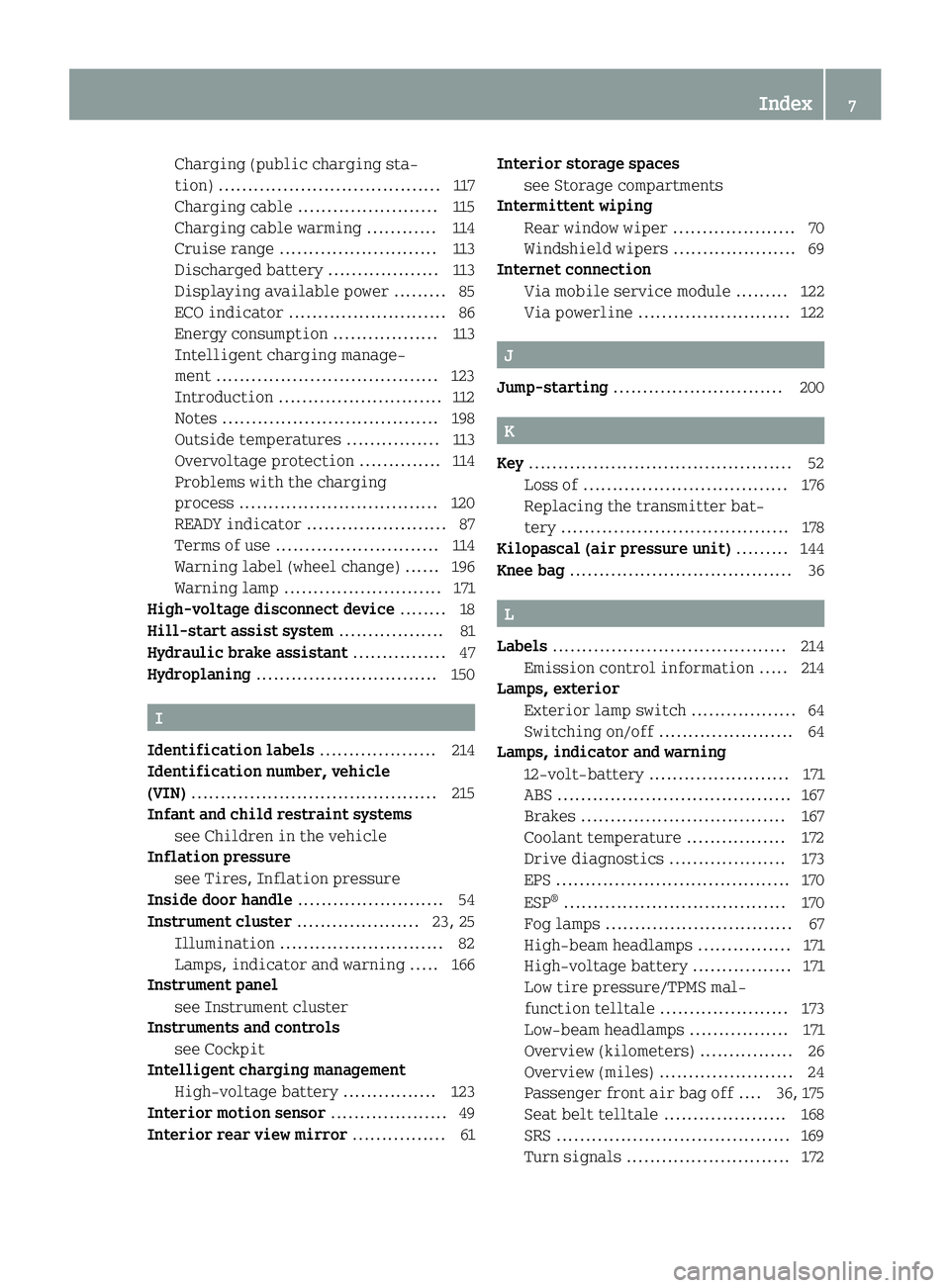
Charging (public charging sta-
tion) ...................................... 117
Charging cable ........................ 115
Charging cable warming ............ 114
Cruise range ........................... 113
Discharged battery ................... 113
Displaying available power ......... 85
ECO indicator ........................... 86
Energy consumption .................. 113
Intelligent charging manage-
ment ...................................... 123
Introduction ............................ 112
Notes ..................................... 198
Outside temperatures ................ 113
Overvoltage protection .............. 114
Problems with the charging
process .................................. 120
READY indicator ........................ 87
Terms of use ............................ 114
Warning label (wheel change) ...... 196
Warning lamp ........................... 171
High-voltage disconnect device ........ 18
Hill-start assist system .................. 81
Hydraulic brake assistant ................ 47
Hydroplaning ............................... 150 I
Identification labels .................... 214
Identification number, vehicle
(VIN) .......................................... 215
Infant and child restraint systems
see Children in the vehicle
Inflation pressure
see Tires, Inflation pressure
Inside door handle ......................... 54
Instrument cluster .....................23, 25
Illumination ............................ 82
Lamps, indicator and warning ..... 166
Instrument panel
see Instrument cluster
Instruments and controls
see Cockpit
Intelligent charging management
High-voltage battery ................ 123
Interior motion sensor .................... 49
Interior rear view mirror ................ 61Interior storage spaces
see Storage compartments
Intermittent wiping
Rear window wiper ..................... 70
Windshield wipers ..................... 69
Internet connection
Via mobile service module ......... 122
Via powerline .......................... 122 J
Jump-starting ............................. 200 K
Key ............................................. 52
Loss of ................................... 176
Replacing the transmitter bat-
tery ....................................... 178
Kilopascal (air pressure unit) ......... 144
Knee bag ...................................... 36 L
Labels ........................................ 214
Emission control information ..... 214
Lamps, exterior
Exterior lamp switch .................. 64
Switching on/off ....................... 64
Lamps, indicator and warning
12-volt-battery ........................ 171
ABS ........................................ 167
Brakes ................................... 167
Coolant temperature ................. 172
Drive diagnostics .................... 173
EPS ........................................ 170
ESP ®
...................................... 170
Fog lamps ................................ 67
High-beam headlamps ................ 171
High-voltage battery ................. 171
Low tire pressure/TPMS mal-
function telltale ...................... 173
Low-beam headlamps ................. 171
Overview (kilometers) ................ 26
Overview (miles) ....................... 24
Passenger front air bag off .... 36, 175
Seat belt telltale ..................... 168
SRS ........................................ 169
Turn signals ............................ 172 Index
7
Page 11 of 222
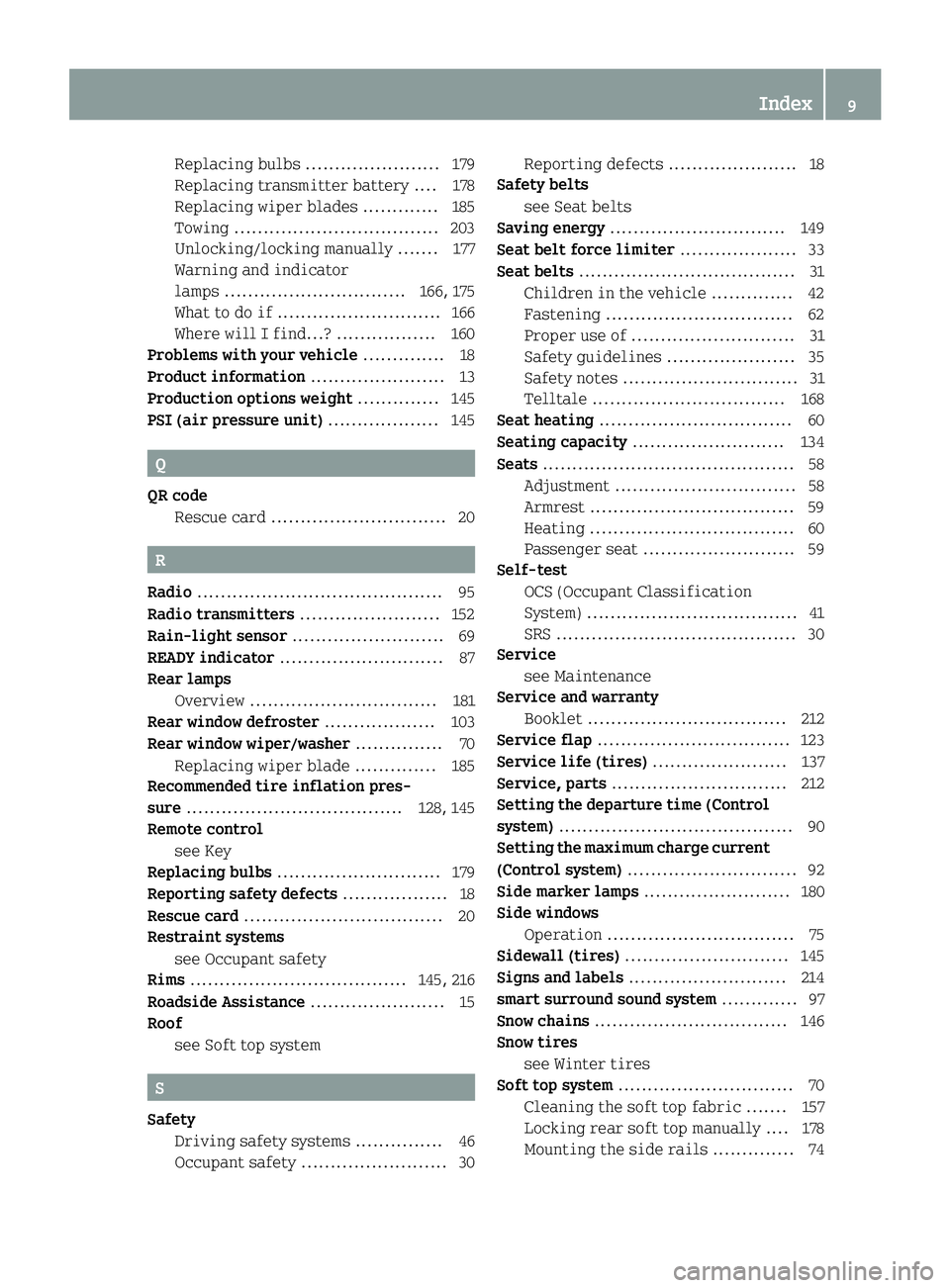
Replacing bulbs ....................... 179
Replacing transmitter battery .... 178
Replacing wiper blades ............. 185
Towing ................................... 203
Unlocking/locking manually ....... 177
Warning and indicator
lamps ............................... 166, 175
What to do if ............................ 166
Where will I find...? ................. 160
Problems with your vehicle .............. 18
Product information ....................... 13
Production options weight .............. 145
PSI (air pressure unit) ................... 145Q
QR code Rescue card .............................. 20 R
Radio .......................................... 95
Radio transmitters ........................ 152
Rain-light sensor .......................... 69
READY indicator ............................ 87
Rear lamps
Overview ................................ 181
Rear window defroster ................... 103
Rear window wiper/washer ............... 70
Replacing wiper blade .............. 185
Recommended tire inflation pres-
sure ..................................... 128, 145
Remote control
see Key
Replacing bulbs ............................ 179
Reporting safety defects .................. 18
Rescue card .................................. 20
Restraint systems
see Occupant safety
Rims ..................................... 145, 216
Roadside Assistance ....................... 15
Roof
see Soft top system S
Safety Driving safety systems ............... 46
Occupant safety ......................... 30 Reporting defects ...................... 18
Safety belts
see Seat belts
Saving energy .............................. 149
Seat belt force limiter .................... 33
Seat belts ..................................... 31
Children in the vehicle .............. 42
Fastening ................................ 62
Proper use of ............................ 31
Safety guidelines ...................... 35
Safety notes .............................. 31
Telltale ................................. 168
Seat heating ................................. 60
Seating capacity .......................... 134
Seats ........................................... 58
Adjustment ............................... 58
Armrest ................................... 59
Heating ................................... 60
Passenger seat .......................... 59
Self-test
OCS (Occupant Classification
System) .................................... 41
SRS ......................................... 30
Service
see Maintenance
Service and warranty
Booklet ................................. .212
Service flap ................................. 123
Service life (tires) ....................... 137
Service, parts .............................. 212
Setting the departure time (Control
system) ....................................... .90
Setting the maximum charge current
(Control system) ............................. 92
Side marker lamps .........................180
Side windows
Operation ................................ 75
Sidewall (tires) ........................... .145
Signs and labels ........................... 214
smart surround sound system ............. 97
Snow chains ................................. 146
Snow tires
see Winter tires
Soft top system .............................. 70
Cleaning the soft top fabric ....... 157
Locking rear soft top manually .... 178
Mounting the side rails .............. 74 Index
9
Page 12 of 222
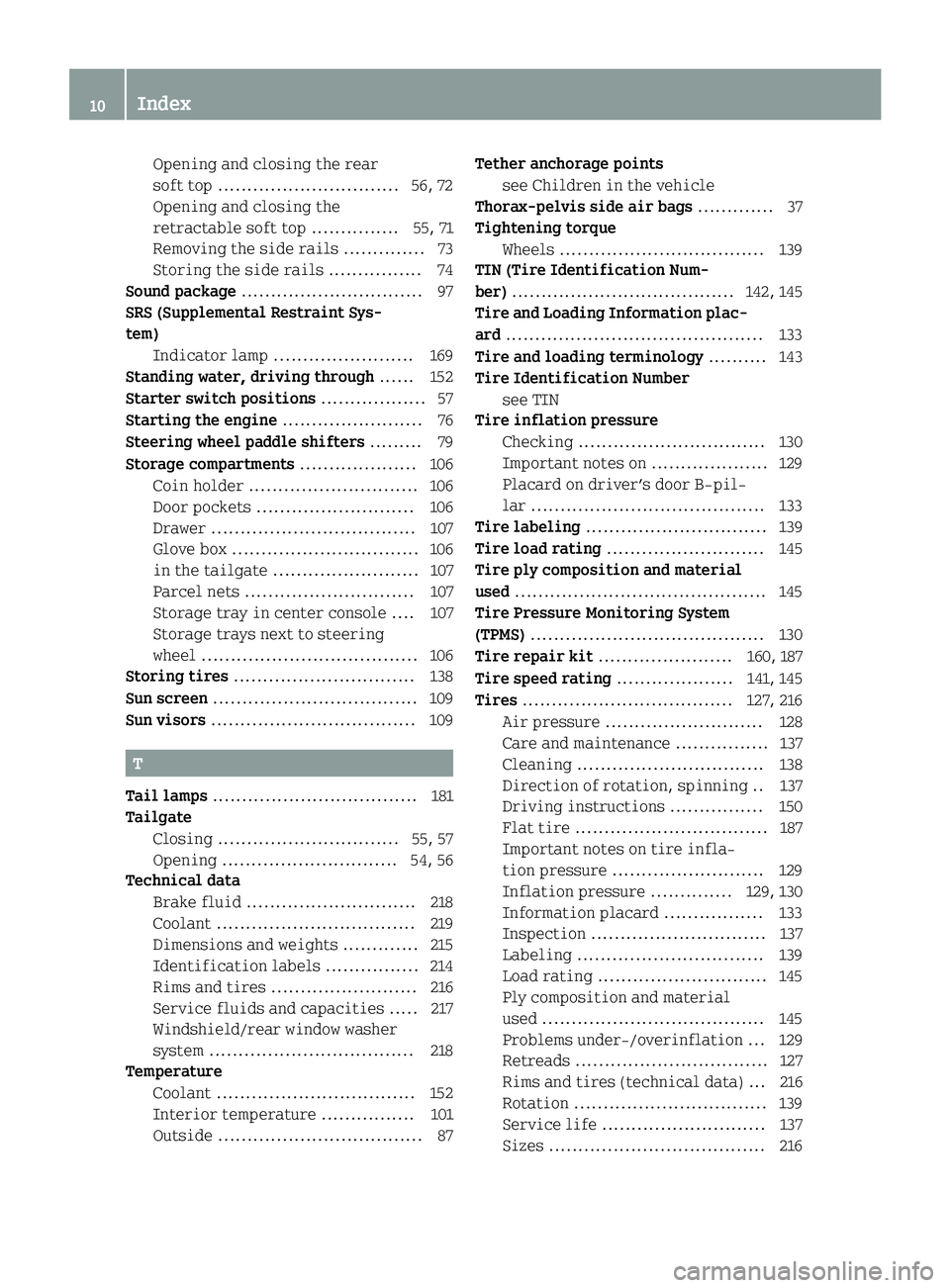
Opening and closing the rear
soft top ............................... 56, 72
Opening and closing the
retractable soft top ............... 55, 71
Removing the side rails .............. 73
Storing the side rails ................ 74
Sound package ............................... 97
SRS (Supplemental Restraint Sys-
tem)
Indicator lamp ........................ 169
Standing water, driving through ...... 152
Starter switch positions .................. 57
Starting the engine ........................ 76
Steering wheel paddle shifters .........79
Storage compartments .................... 106
Coin holder ............................. 106
Door pockets ........................... 106
Drawer ................................... 107
Glove box ................................ 106
in the tailgate ........................ .107
Parcel nets ............................ .107
Storage tray in center console .... 107
Storage trays next to steering
wheel .................................... .106
Storing tires ............................... 138
Sun screen ................................... 109
Sun visors ................................... 109 T
Tail lamps ................................... 181
Tailgate
Closing ............................... 55, 57
Opening .............................. 54, 56
Technical data
Brake fluid ............................ .218
Coolant ................................. .219
Dimensions and weights ............ .215
Identification labels ............... .214
Rims and tires ........................ .216
Service fluids and capacities ..... 217
Windshield/rear window washer
system ................................... 218
Temperature
Coolant ................................. .152
Interior temperature ................ 101
Outside ................................... 87 Tether anchorage points
see Children in the vehicle
Thorax-pelvis side air bags ............. 37
Tightening torque
Wheels ................................... 139
TIN (Tire Identification Num-
ber) ...................................... 142, 145
Tire and Loading Information plac-
ard ............................................ 133
Tire and loading terminology .......... 143
Tire Identification Number
see TIN
Tire inflation pressure
Checking ................................ 130
Important notes on .................... 129
Placard on driver’s door B-pil-
lar ........................................ 133
Tire labeling ...............................1 39
Tire load rating ........................... 145
Tire ply composition and material
used ........................................... 145
Tire Pressure Monitoring System
(TPMS) ........................................ 130
Tire repair kit ....................... 160, 187
Tire speed rating .................... 141, 145
Tires .................................... 127, 216
Air pressure ........................... 128
Care and maintenance ................ 137
Cleaning ................................ 138
Direction of rotation, spinning .. 137
Driving instructions ................ 150
Flat tire ................................. 187
Important notes on tire infla-
tion pressure .......................... 129
Inflation pressure .............. 129, 130
Information placard ................. 133
Inspection .............................. 137
Labeling ................................ 139
Load rating ............................. 145
Ply composition and material
used ...................................... 145
Problems under-/overinflation ... 129
Retreads ................................. 127
Rims and tires (technical data) ... 216
Rotation ................................. 139
Service life ............................ 137
Sizes ..................................... 216 10
Index
Page 14 of 222
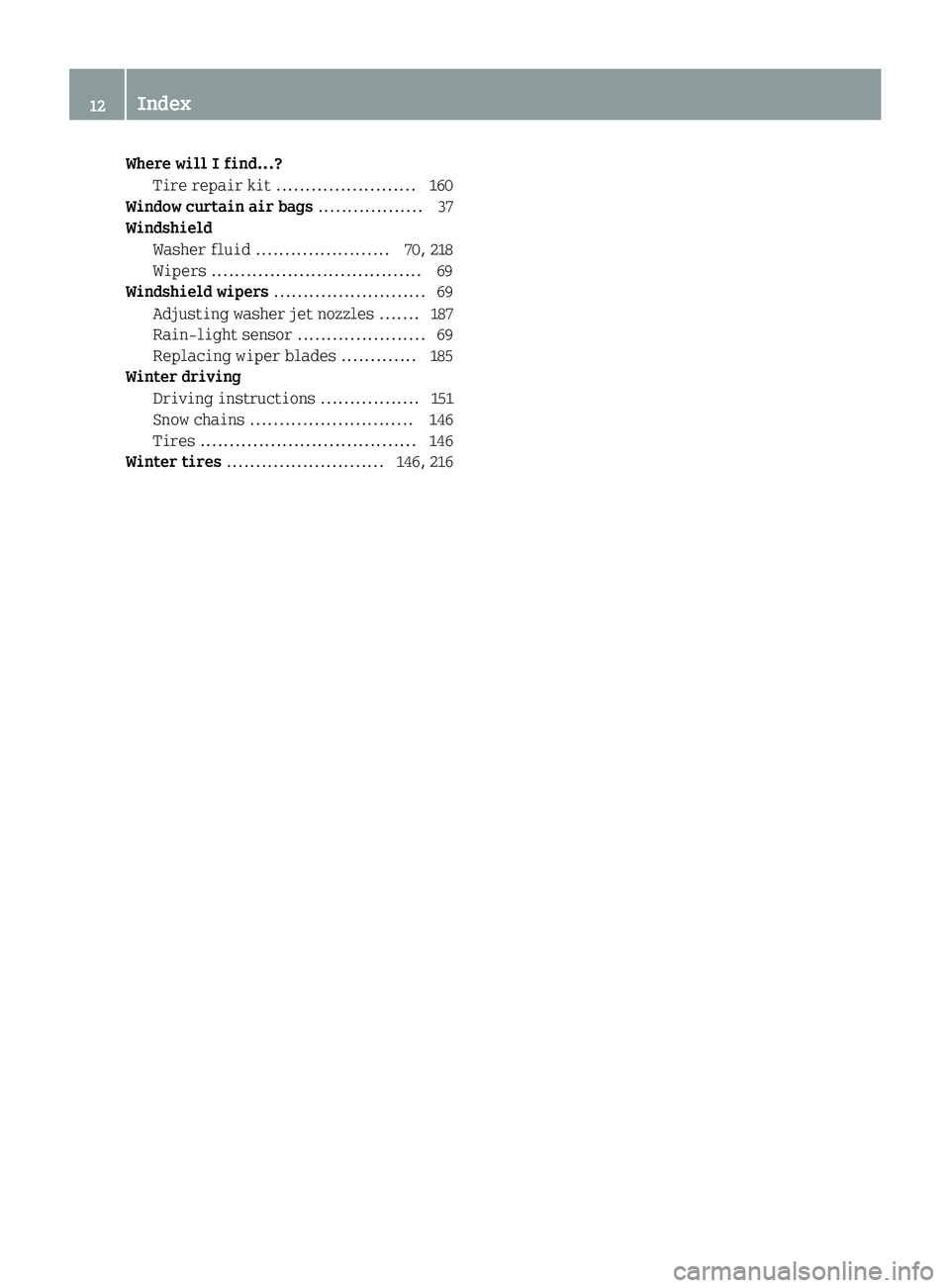
Where will I find...?
Tire repair kit ........................ 160
Window curtain air bags .................. 37
Windshield
Washer fluid ....................... 70, 218
Wipers .................................... 69
Windshield wipers .......................... 69
Adjusting washer jet nozzles ....... 187
Rain-light sensor ...................... 69
Replacing wiper blades ............ .185
Winter driving
Driving instructions ................. 151
Snow chains ........................... .146
Tires ..................................... 146
Winter tires ........................... 146, 21612
Index
Page 30 of 222
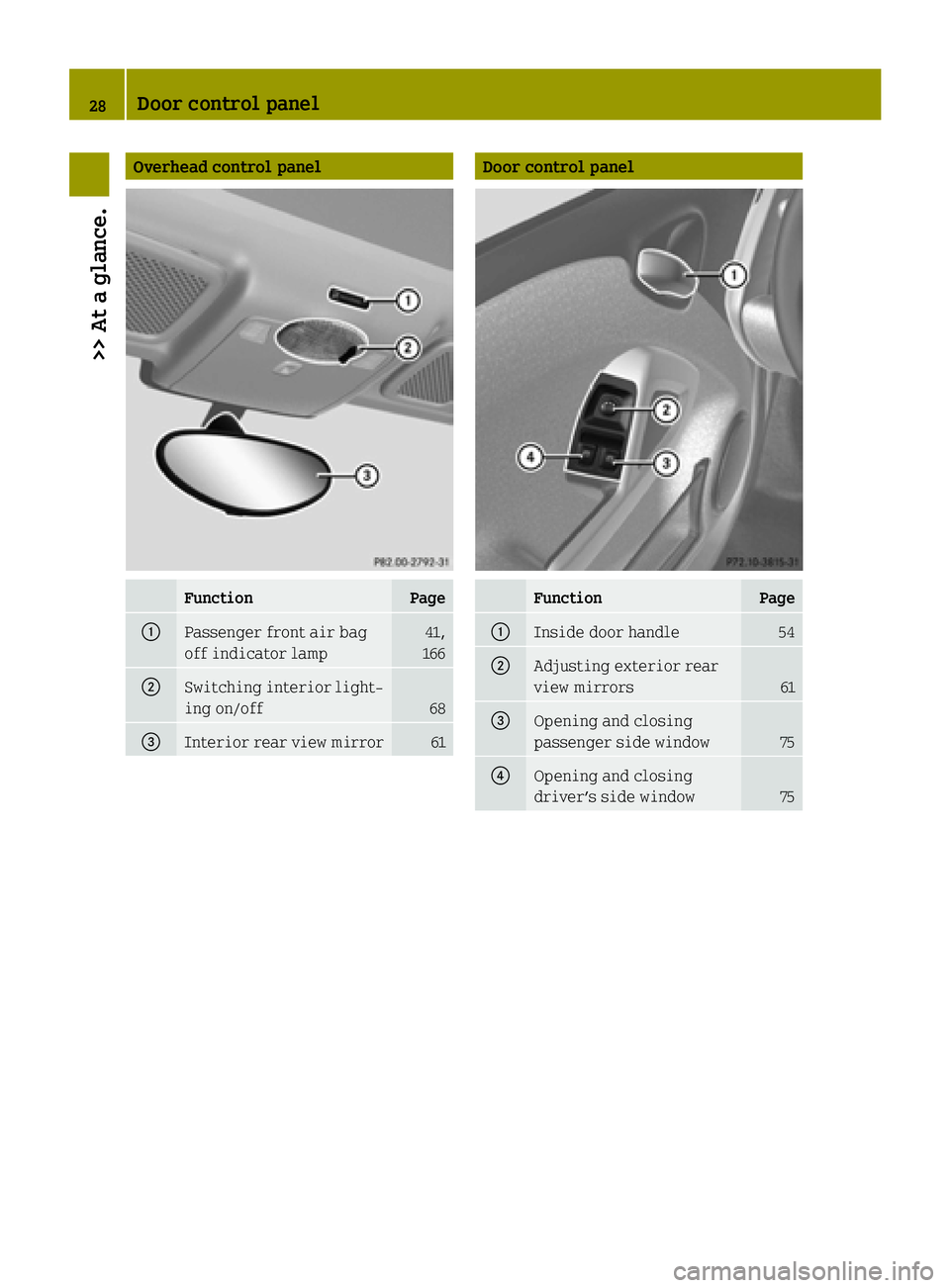
Overhead control panel
Function Page
:
Passenger front air bag
off indicator lamp 41,
166 ;
Switching interior light-
ing on/off 68
=
Interior rear view mirror 61 Door control panel
Function Page
:
Inside door handle 54
;
Adjusting exterior rear
view mirrors
61
=
Opening and closing
passenger side window
75
?
Opening and closing
driver’s side window
7528
Door control panel>> At a glance.
Page 35 of 222
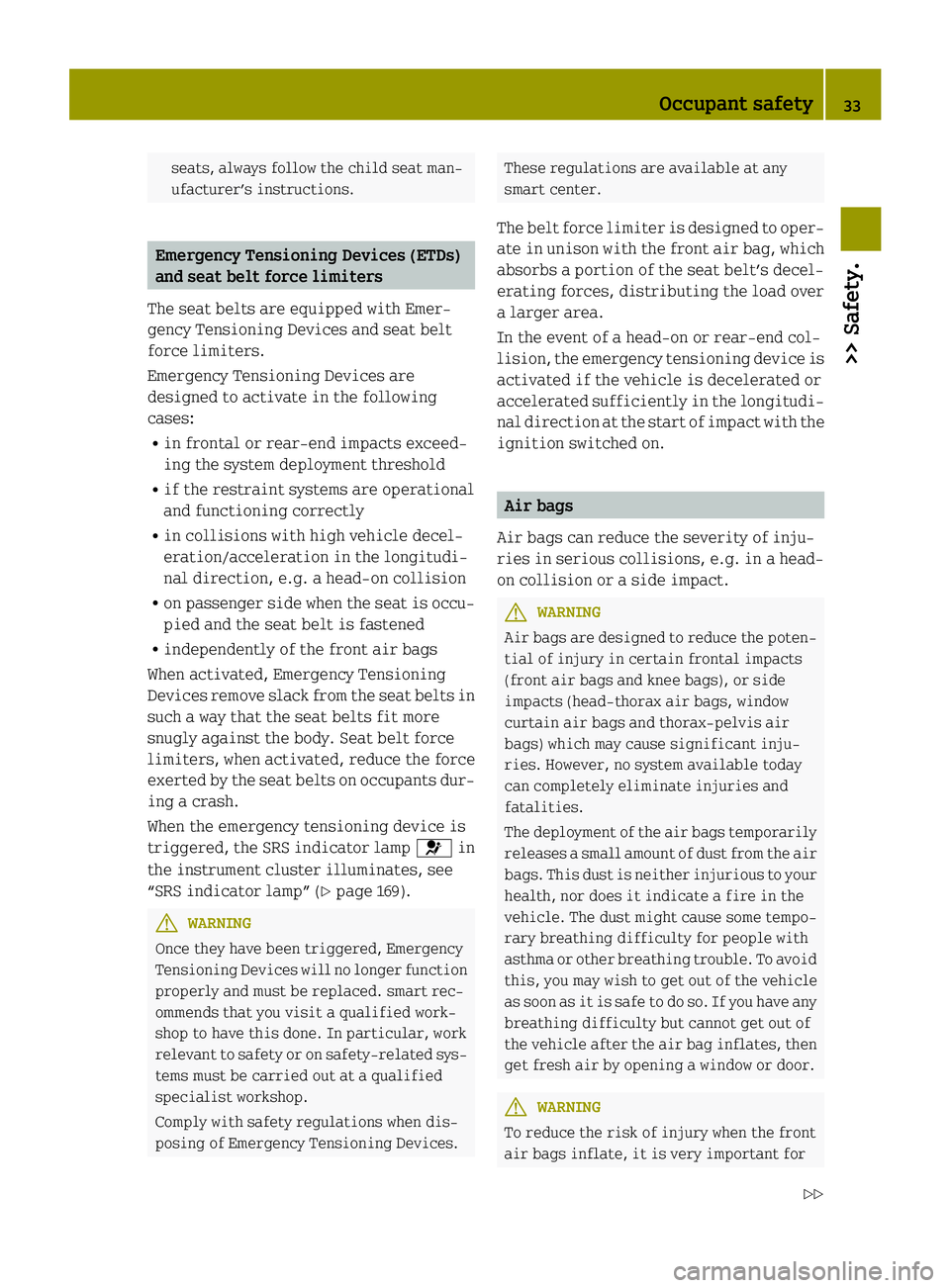
seats, always follow the child seat man-
ufacturer’s instructions. Emergency Tensioning Devices (ETDs)
and seat belt force limiters
The seat belts are equipped with Emer-
gency Tensioning Devices and seat belt
force limiters.
Emergency Tensioning Devices are
designed to activate in the following
cases:
R in frontal or rear-end impacts exceed-
ing the system deployment threshold
R if the restraint systems are operational
and functioning correctly
R in collisions with high vehicle decel-
eration/acceleration in the longitudi-
nal direction, e.g. a head-on collision
R on passenger side when the seat is occu-
pied and the seat belt is fastened
R independently of the front air bags
When activated, Emergency Tensioning
Devices remove slack from the seat belts in such a way that the seat belts fit more
snugly against the body. Seat belt force
limiters, when activated, reduce the force
exerted by the seat belts on occupants dur-
ing a crash.
When the emergency tensioning device is
triggered, the SRS indicator lamp 6in
the instrument cluster illuminates, see
“SRS indicator lamp” (Y page 169).G
WARNING
Once they have been triggered, Emergency
Tensioning Devices will no longer function properly and must be replaced. smart rec-
ommends that you visit a qualified work-
shop to have this done. In particular, work
relevant to safety or on safety-related sys-tems must be carried out at a qualified
specialist workshop.
Comply with safety regulations when dis-
posing of Emergency Tensioning Devices. These regulations are available at any
smart center.
The belt force limiter is designed to oper- ate in unison with the front air bag, which
absorbs a portion of the seat belt’s decel-
erating forces, distributing the load over
a larger area.
In the event of a head-on or rear-end col-
lision, the emergency tensioning device is
activated if the vehicle is decelerated or
accelerated sufficiently in the longitudi- nal direction at the start of impact with theignition switched on. Air bags
Air bags can reduce the severity of inju-
ries in serious collisions, e.g. in a head-
on collision or a side impact. G
WARNING
Air bags are designed to reduce the poten- tial of injury in certain frontal impacts
(front air bags and knee bags), or side
impacts (head-thorax air bags, window
curtain air bags and thorax-pelvis air
bags) which may cause significant inju-
ries. However, no system available today
can completely eliminate injuries and
fatalities.
The deployment of the air bags temporarily
releases a small amount of dust from the air
bags. This dust is neither injurious to your health, nor does it indicate a fire in the
vehicle. The dust might cause some tempo-
rary breathing difficulty for people with
asthma or other breathing trouble. To avoid
this, you may wish to get out of the vehicle
as soon as it is safe to do so. If you have any
breathing difficulty but cannot get out of
the vehicle after the air bag inflates, then get fresh air by opening a window or door. G
WARNING
To reduce the risk of injury when the front
air bags inflate, it is very important for Occupant safety
33>> Safety.
Z
Page 36 of 222
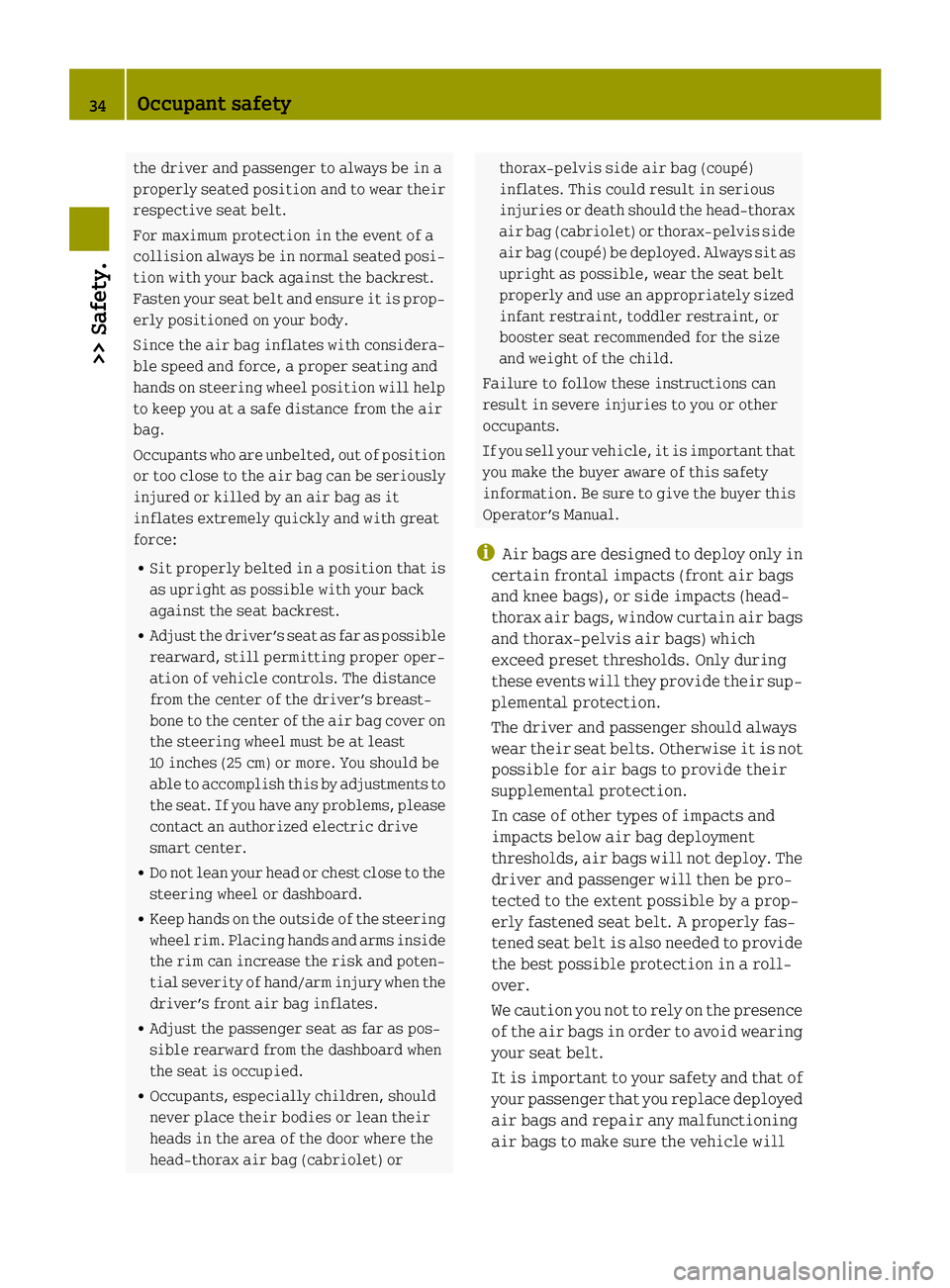
the driver and passenger to always be in a
properly seated position and to wear their respective seat belt.
For maximum protection in the event of a
collision always be in normal seated posi-
tion with your back against the backrest.
Fasten your seat belt and ensure it is prop-
erly positioned on your body.
Since the air bag inflates with considera- ble speed and force, a proper seating and
hands on steering wheel position will help
to keep you at a safe distance from the air
bag.
Occupants who are unbelted, out of position
or too close to the air bag can be seriously
injured or killed by an air bag as it
inflates extremely quickly and with great
force:
R Sit properly belted in a position that is
as upright as possible with your back
against the seat backrest.
R Adjust the driver’s seat as far as possible
rearward, still permitting proper oper-
ation of vehicle controls. The distance
from the center of the driver’s breast-
bone to the center of the air bag cover on
the steering wheel must be at least
10 inches (25 cm) or more. You should be
able to accomplish this by adjustments to the seat. If you have any problems, please contact an authorized electric drive
smart center.
R Do not lean your head or chest close to the
steering wheel or dashboard.
R Keep hands on the outside of the steering
wheel rim. Placing hands and arms inside the rim can increase the risk and poten-
tial severity of hand/arm injury when the
driver’s front air bag inflates.
R Adjust the passenger seat as far as pos-
sible rearward from the dashboard when
the seat is occupied.
R Occupants, especially children, should
never place their bodies or lean their
heads in the area of the door where the
head-thorax air bag (cabriolet) or thorax-pelvis side air bag (coupé)
inflates. This could result in serious
injuries or death should the head-thorax air bag (cabriolet) or thorax-pelvis side
air bag (coupé) be deployed. Always sit as
upright as possible, wear the seat belt
properly and use an appropriately sized
infant restraint, toddler restraint, or
booster seat recommended for the size
and weight of the child.
Failure to follow these instructions can
result in severe injuries to you or other
occupants.
If you sell your vehicle, it is important that you make the buyer aware of this safety
information. Be sure to give the buyer this
Operator’s Manual.
i Air bags are designed to deploy only in
certain frontal impacts (front air bags
and knee bags), or side impacts (head-
thorax air bags, window curtain air bags and thorax-pelvis air bags) which
exceed preset thresholds. Only during
these events will they provide their sup-
plemental protection.
The driver and passenger should always
wear their seat belts. Otherwise it is not
possible for air bags to provide their
supplemental protection.
In case of other types of impacts and
impacts below air bag deployment
thresholds, air bags will not deploy. The
driver and passenger will then be pro-
tected to the extent possible by a prop-
erly fastened seat belt. A properly fas-
tened seat belt is also needed to provide the best possible protection in a roll-
over.
We caution you not to rely on the presence
of the air bags in order to avoid wearing your seat belt.
It is important to your safety and that of
your passenger that you replace deployed
air bags and repair any malfunctioning
air bags to make sure the vehicle will 34
Occupant safety>> Safety.
Page 39 of 222
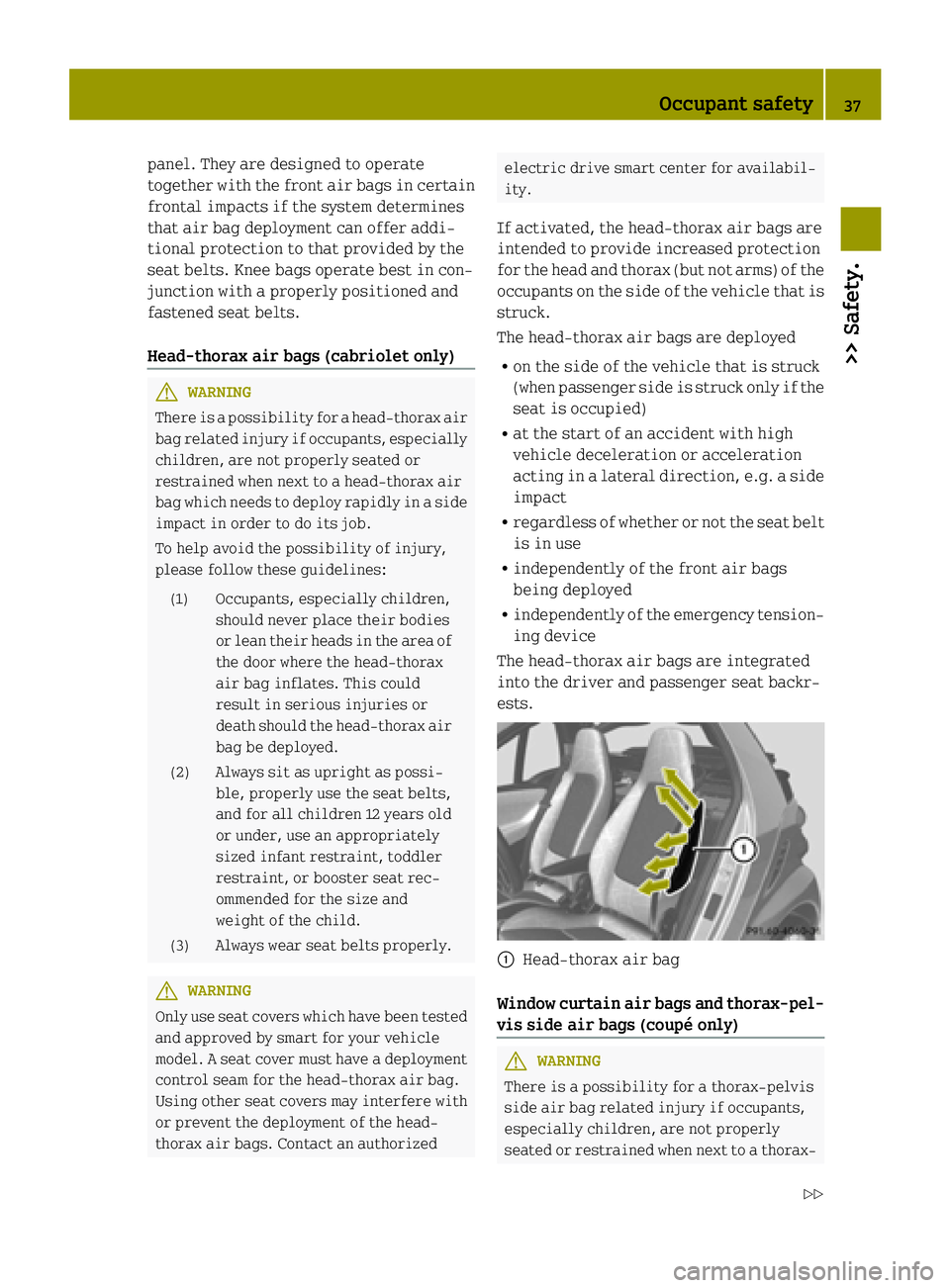
panel. They are designed to operate
together with the front air bags in certain
frontal impacts if the system determines
that air bag deployment can offer addi-
tional protection to that provided by the
seat belts. Knee bags operate best in con-
junction with a properly positioned and
fastened seat belts.
Head-thorax air bags (cabriolet only) G
WARNING
There is a possibility for a head-thorax air bag related injury if occupants, especially children, are not properly seated or
restrained when next to a head-thorax air
bag which needs to deploy rapidly in a side
impact in order to do its job.
To help avoid the possibility of injury,
please follow these guidelines:
(1) Occupants, especially children, should never place their bodies
or lean their heads in the area of
the door where the head-thorax
air bag inflates. This could
result in serious injuries or
death should the head-thorax air
bag be deployed.
(2) Always sit as upright as possi- ble, properly use the seat belts,
and for all children 12 years old
or under, use an appropriately
sized infant restraint, toddler
restraint, or booster seat rec-
ommended for the size and
weight of the child.
(3) Always wear seat belts properly. G
WARNING
Only use seat covers which have been tested and approved by smart for your vehicle
model. A seat cover must have a deploymentcontrol seam for the head-thorax air bag.
Using other seat covers may interfere with
or prevent the deployment of the head-
thorax air bags. Contact an authorized electric drive smart center for availabil-
ity.
If activated, the head-thorax air bags are
intended to provide increased protection
for the head and thorax (but not arms) of the
occupants on the side of the vehicle that is struck.
The head-thorax air bags are deployed
R on the side of the vehicle that is struck
(when passenger side is struck only if the
seat is occupied)
R at the start of an accident with high
vehicle deceleration or acceleration
acting in a lateral direction, e.g. a side
impact
R regardless of whether or not the seat belt
is in use
R independently of the front air bags
being deployed
R independently of the emergency tension-
ing device
The head-thorax air bags are integrated
into the driver and passenger seat backr-
ests. :
Head-thorax air bag
Window curtain air bags and thorax-pel- vis side air bags (coupé only) G
WARNING
There is a possibility for a thorax-pelvis
side air bag related injury if occupants,
especially children, are not properly
seated or restrained when next to a thorax- Occupant safety
37>> Safety.
Z